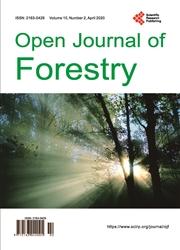Soil Trafficability Forecasting
引用次数: 9
Abstract
This article introduces and evaluates a Soil Trafficability Model (STRAM) designed to estimate and forecast potential rutting depth on forest soils due to heavy machine traffic. This approach was developed within the wood-forwarding context of four harvest blocks in Northern and Central New Brunswick. Field measurements used for model calibration involved determining soil rut depths, volumetric moisture content, bulk density, soil resistance to cone penetration (referred to as cone index, or CI), and the dimensionless nominal soil cone index (NCI) defined by the ratio of CI over wheel foot print pressure. With STRAM, rut depth is inferred from: 1) machine dimensions pertaining to estimating foot print area and pressure; 2) pore-filled soil moisture content and related CI projections guided by year-round daily weather records using the Forest Hydrology Model (ForHyM); 3) accounting for within-block soil property variations using multiple and Random Forest regression techniques. Subsequent evaluations of projected soil moisture, CI and rut-depth values accounted for about 40 (multiple regression) and 80 (Random Forest) percent of the corresponding field measured values.土壤可通性预测
本文介绍并评估了一个土壤可通行性模型(STRAM),该模型旨在估计和预测重型机器交通导致的森林土壤潜在车辙深度。这种方法是在新不伦瑞克省北部和中部四个收获区块的木材运输背景下制定的。用于模型校准的现场测量包括确定土壤车辙深度、体积含水量、体积密度、土壤对圆锥贯入的阻力(称为圆锥指数或CI),以及由CI与车轮脚印压力之比定义的无量纲标称土壤圆锥指数(NCI)。使用STRAM,车辙深度可以从以下方面推断:1)与估计脚印面积和压力有关的机器尺寸;2) 孔隙填充土壤含水量和相关CI预测,以全年每日天气记录为指导,使用森林水文模型(ForHyM);3) 使用多元和随机森林回归技术解释块内土壤性质变化。随后对预计土壤湿度、CI和车辙深度值的评估约占相应现场测量值的40%(多元回归)和80%(随机森林)。
本文章由计算机程序翻译,如有差异,请以英文原文为准。
求助全文
约1分钟内获得全文
求助全文

 求助内容:
求助内容: 应助结果提醒方式:
应助结果提醒方式:


